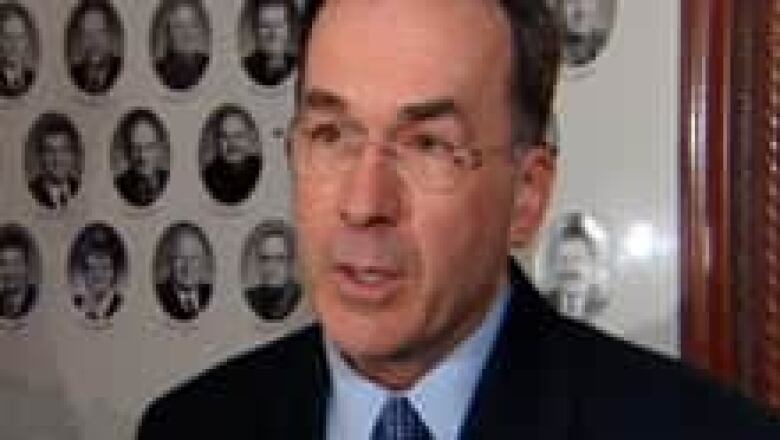Bruce Northrup unveils new forestry plan
Annual allowable cut for softwood lumber remains the same
Natural Resources Minister Bruce Northrup is holding the line on the annual allowable cut for softwood lumber in the provincial governments new forestry policy.
Northrup made the long-awaited announcement today in Fredericton.
The annual allowable cut for softwood, such as spruce, fir and jack pine, is 3.27 million cubic metres, which is the sameannual allowable cutas in the 2007-2012 management plan.
Northrup said the departments projections show the annual allowable cut for softwood lumber can be maintained at the existing level.
"All our information indicates there will be a rapidly growing wood supply beginning around 2030 as these managed stands mature,'' Northrup said.
"Until then, we are confident there will be enough wood to at least maintain the softwood AAC at the present level and that is our objective.''
Meanwhile, the Department of Natural Resources is cutting the annual allowable cut for hardwood to 1.41 million cubic metres from 1.77 million cubic metres in the 2007-2012 plan. The 21 per cent reduction will ensure a sustainable hardwood supply in the future, according to the department.
"It would be in no one's interest to harvest hardwood species at a level that would require an even larger AAC reduction in the future, the natural resources minister said.
"This reduction is necessary and, at the same time, it represents an opportunity for the province's private woodlot sector to sell more wood into the marketplace, which is a top priority for our government.''
Northrup said his forest management plan is "balanced." He said it would help support the environment and maintain jobs in the industry.
"It strikes the best balance possible while preserving jobs in rural and northern New Brunswick, where forestry remains a major employer and a $2.7-billion industry," he said.
The forest management plan also outlined how:
- the amount of forested Crown land designated as protected natural areas is increased to eight per cent.
- 28 per cent of Crown forest is designated as "conservation forest."
- "non-clearcut harvesting measures" would be implemented.
The management plan starts in April 2012 and continues until March 31, 2022. The 10-year plan is double the normal length of the previous forest management plans.
Northrup said the recommendation for a longer management plan came from a government-appointed management plan.
"The Crown Land Task Force on timber objectives recommended we move to a 10-year planning cycle in order to provide greater certainty on allocation levels as well as commitments to conservation measures,'' Northrup said.
The natural resources minister said the longer plan will give more predictability for the forest industry.
The Alward government hired two task forces to study Crown land and private land task force.
Environmental support

Northrup's plan received some cautious praise from the province's largest environmental group.
David Coon, the executive director of the Conservation Council of New Brunswick, said he has concerns with the forest management strategy, but said it is a vast improvement.
"The plan they released today is far better than what the industry was lobbying for and it is far better than what the Liberals had proposed when they were they government, he said.
"But it is moving in the wrong direction for most New Brunswickers who say their number one priority areas are to protect water and to protect wildlife."
Coon said he's concerned about a reduction of deer wintering areas and the size of buffer zones around water courses.
The forest, which is set aside for habitat zones and watercourse buffers, will be reduced to 28 per cent from 30.5 per cent, Coon said.
Industry concerns

Several forest operations in the province have closed in recent months becausein the uncertainty of the industry.
Robert Fawcett, the director of forestry relations for J.D. Irving Ltd., saidits Clair and Deersdale mills will remain closed. He blamed the extended closure on cost uncertainty in the government's plan.
He said the company is "really concerned" about the impact on its employees and the communities where its mills operate.
"For us at the moment, our mill capital expansions are put on hold, Fawcett said.
"We are not going to be able to invest in ourfacilities today until we hear a more certain number in terms of the wood that is going to be available for those facilities."
The closure of the Deersdale millnear Juniper put more than 70 people out of work in October.
Another 73 people were put out of work in September whenJ.D. Irving closed its mill in Clair.
The forest industry had been lobbying to make sure the annual allowable cut was not reduced.
Last June, J.D. Irving Ltd. organized a petition campaign aimed at provincial politicians that said hundreds of jobs were at stake if the provincial government reduces allowable cuts of some types of trees by 25 per cent.
Fawcett said J.D. Irving Ltd. is very concerned about the new standards that are being put in place, which will make it more expensive to cut trees in the province.
"We need to be very concerned about the implementation about these new standards that DNR is putting in place by April 1. These new standards will increase the cost of harvesting wood significantly," he said.
The new standards will mean younger and smaller trees will be cut, Fawcett said, which will increase the cost to log, transport and then process the trees.












_(720p).jpg)


 OFFICIAL HD MUSIC VIDEO.jpg)
.jpg)



























































































